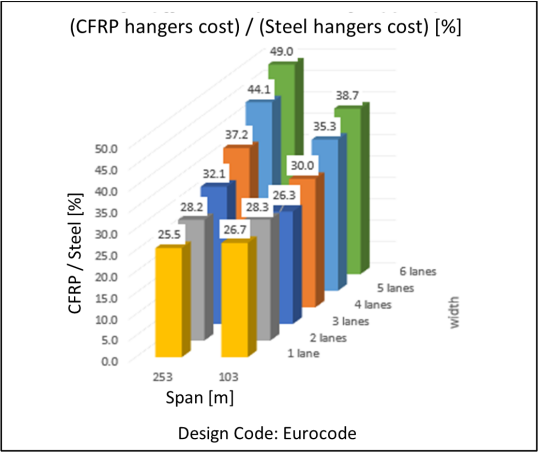On the application of carbon fibre-reinforced polymers in bridge design
Author: Pascal Hodel
Language: English
Abstract
Conventional steel-based hangers, commonly used in network tied-arch bridges, are often susceptible to durability (corrosion) and fatigue issues during their service life. The use of carbon fibre-reinforced polymers (CFRP) hangers has been considered as a promising alternative, given the material’s superior corrosion and fatigue performance and despite its relatively high unit cost. The aim of this thesis was to determine certain geometrical parameters, for the case of network tied-arch bridges carrying road traffic, under which the use of CFRP hangers could be economically advantageous. To this end, both initial and life-cycle costs were considered in the investigation.
To explore the practical limits of economic application of CFRP hangers, a parametric study was performed, using the software tool Rhino/Grasshopper, coupled with the general-purpose analysis software Sofistik. The studied geometric parameters included the span and width (number of lanes) of the bridge. In addition, the sensitivity to the applicable traffic load models was investigated by considering the Swiss, European and US codes (SIA, EN and AASHTO, respectively).
The parametric study indicated that the size of the hangers is governed by the fatigue limit state (FLS) in the case of short/narrow bridges, while the ultimate limit state (ULS) is governing for longer/wider bridges. For the assumed material properties, dimensioning methodology (dimensioning of CFRP members is not currently codified), and unit costs, it was concluded that CFRP hangers become competitive when the required cross section of the steel hangers option under the FLS is about twice of that under the ULS, i.e. the FLS must be governing the size of the hangers by a substantial margin over the ULS. Furthermore, it was revealed that the outcome of the study heavily depends on the adopted design code and the respective traffic load models. As the AASHTO fatigue load model imposes significantly less demands on the hangers than the SIA or Eurocode models do, CFRP hangers are generally less competitive under AASHTO provisions (see figures).
To provide definitive recommendations on the required geometric parameters for the CFRP hangers to be competitive, further investigation is needed with respect to hanger anchorage detailing and installation cost. Furthermore, the interaction of the CFRP hanger network with the arch system must be studied in more detail: in general, higher bending demands in the arch and tie are observed compared to an equivalent steel hanger network. Nonetheless, the adoption of CFRP hangers appears to be a promising solution, particularly for network tied-arch bridges designed according to European codes (EN/SIA).


